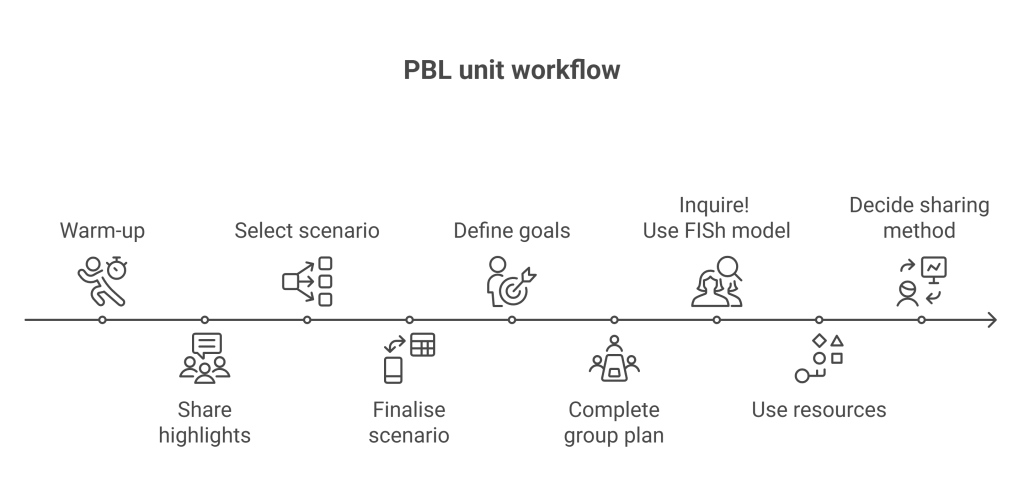14 Unit 2 Learning theories, frameworks and practice in the digital age
Introduction to unit
Understanding how people learn is fundamental to designing effective educational experiences, especially in a digital society. This unit delves into contemporary learning theories and pedagogical frameworks that inform digital education. We explore key theoretical families such as social constructivism, communities of practice, and connectivism, which emphasize collaboration, shared knowledge, and networked learning. Building on these foundations, we examine practical frameworks like SETI and AI-TPACK that support educators in integrating digital tools meaningfully into their teaching. By connecting theory with practice, this unit equips participants with the conceptual and practical tools needed to navigate and shape learning in digitally mediated environments.

PBL unit workflow overview

Individual warm-up activities
Activity 1: Familiarise yourself with key learning theories and select three that currently characterise your practice. The HoTEL map will help you see the big learning theories as families. Reach out to specific academic sources linked to the ones you select. Create a mini marketing poster for each to sell it to colleagues based on how you use specific theories in your practice. You may wish to use low tech materials such as pen and paper, a drawing app or Canva.
Activity 2: Familiarise yourself with the SETI Framework (Crompton et al. 2024). Identify how this framework relates to you as an educator and the way you integrate technology in your practice. Write a reflection in the form of a short poem. No need to follow writing conventions or create a rhyming poem. Define your own rules!
Activity 3: When you have completed Activity 1 and 2 think about the future and alternative possibilities for digital practice in your professional context based on specific pedagogies and frameworks. Ask yourself 3 “What if” questions and attempt to answer these critically and creatively. Share these with at least one of your peers and engage in a conversation about these with them and their “What if” questions. To complement this inquiry you may wish to go to Microsoft Copilot and invite GenAI to ask you three critical questions based on one of your “What if” questions and the response you gave. Avoid adding personal details into Copilot. What did this exchange enable? How does this experience compare to having a conversation with your peers? Revisit this activity after the group task for this unit.
Sharing
When you have completed the warm-up activities share these with your group and discuss. What do you notice? Capture three learning points.
Scenario
Choose a scenario from Part 2 that links with this unit or generate your own based on tailored parameters that closer align to your professional context as a group. You can do this manually or use GenAI. You will find instructions there.
You will need to save the scenario your group decides to use (e.g. the collaborative space in Teams). Add it to your collaborative learning space so that you can all easily access it.
Once this is done, continue with the tasks that follow.
What would you like to achieve as a group?
This will be really important to agree as a group as it will be driving what you will be working on as a group and put a plan together on how you can be successful in achieving what you set out to do. Consider using a coaching model such as GROW (Whitmore, 1996).
Group unit learning outcomes
After reading the scenario carefully and discussing in the group on which aspect of the scenario you will be focusing on, define your learning outcome(s)
LO1
LO2
Using Step 1: Focus, from the FISh model will help you with this (See section Working with FISh).
Module learning outcomes
Explain how your learning outcome(s) relates to the module learning outcomes.
On successful completion of the module you will have demonstrated the following Learning Outcomes (LO) relevant to the subject:
LO1: Critically assess key contemporary debates of digital technology, education and society in your professional context.
LO2: Apply specific learning theories relevant to digital education in your professional context.
LO3: Critically reflect on a range of digital technologies and practices in your professional context.
Skills Learning Outcomes
On successful completion of the module students will have demonstrated the following skills learning outcomes:
SLO1: Critically reflect on the use of digital education in your own professional practice
SLO2: Expand your professional network of digital education practitioners and become an active and valued member of such communities both online and in person
SKL3: Collaborate effectively online using a range of digital communication tools with other digital education practitioners
SLO4: Use appropriate digital tools to present and communicate information
Group plan
Use this table to capture all information relating to your work linked to this unit. Using Step 2 and Step 3 of the FISh model will help you with this (see section working with FISh).
| What would you like to achieve as a group | |
| Timeline | |
| Who will do what and by when | |
| Digital tools needed/used | |
| Final output, format | |
| Assessment criteria for group evaluation
(Use the ones agreed for the module) |
|
| Group reflection and learning | |
| What resources can we use | |
| What other resources do we need | |
| How can the tutor support us |
Literature
Akpan, V. I., Igwe, U. A., Mpamah, I. B. I. and Okoro, C. O. 2020. Social constructivism: Implications on teaching and learning. British Journal of Education. 8(8), 49-56. https://www.eajournals.org/wp-content/uploads/Social-Constructivism.pdf
Crompton, H., Burke, D., Nickel, C., and Chigona, A. 2024. The SETI framework and technology integration in the digital age. Asian Journal of Distance Education, 19, 167-176. https://www.asianjde.com/ojs/index.php/AsianJDE/article/view/771
Ning, Y., Zhang, C., Xu, B., Zhou, Y. and Wijaya, T.T. 2024. Teachers’ AI-TPACK: Exploring the Relationship between Knowledge Elements. Sustainability (Switzerland). 16(3). https://doi.org/10.3390/su16030978
Doan, V. R. 2024. Analysis of Confucius and Dewey’s educational ideas for Vietnam’s education. ACTA SCIENTIAE, 7(1), 288-300. https://periodicosulbra.org/index.php/acta/article/view/24
Siemens, G. 2005. Connectivism: A Learning Theory for the Digital Age. ITDL Journal. http://www.itdl.org/Journal/Jan_05/article01.htm
Wenger-Trayner, E., Wenger-Trayner, B. Reid, P. and Bruderlein, C. 2023. Communities of practice within and across organizations. A guidebook (2nd edition). https://www.wenger-trayner.com/cop-guidebook/#pdf
Multimedia resources Food for thought series created with our students
External multimedia resources
Vygotsky’s Theory of Cognitive Development in Social Relationships
https://youtu.be/8I2hrSRbmHE?feature=shared
Connectivism, a learning theory

